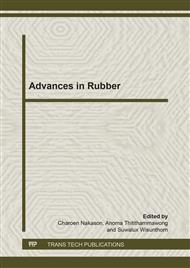p.474
p.478
p.482
p.486
p.490
p.494
p.498
p.502
p.507
Current Study on Structural Characterization and Unique Film Formation of Hevea brasiliensis Natural Rubber Latex
Abstract:
Hevea brasiliensis natural rubber (NR) latex is a very important commercial source of elastomers. It is not only a source for dry NR rubber but also the feedstock for the latex glove dipping industry. The particles of freshly tapped latex are known to be stabilized by proteins and lipids that come with the latex from the tree. These non-rubbers [, especially proteins and lipids, confer to the rubber and latex excellent properties unsurpassed by any synthetic latex [. Recent structural studies of NR revealed that the NR molecules comprise of 2 trans-isoprene units connected to a long-chain cis-isoprene units. Two terminal groups, referred to as ω and α, have been postulated to link with mono-and di-phosphate groups associated with phospholipids by H-bonding at the α-terminal, whereas the ω-terminal is a dimethylallyl group links to protein by H-bonding [. Although numerous studies have been published on the surface structure of the natural rubber particle [4-, none of these offered a direct in situ visualization of the intact particle surface. This is because of any attempt to remove this surface layer of proteins and lipids results in an immediate destabilization of the latex. The second part focused on the using of Atomic Force Microscopy (AFM) and Confocal Fluorescence microscopy to visualize and delineate the structure of the proteins and lipids layer on the latex particle surface in situ.
Info:
Periodical:
Pages:
498-501
Citation:
Online since:
November 2013
Authors:
Keywords:
Price:
Сopyright:
© 2014 Trans Tech Publications Ltd. All Rights Reserved
Share:
Citation:


